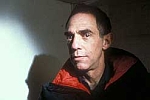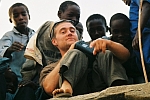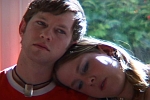 Shadows off the beaten path
Shadows off the beaten pathRED WITHOUT BLUE | SHINE A LIGHT
< < D O C S > >
last update 2.Apr.08
See also: SHADOWS FILM FESTIVAL
 R E V I E W B Y R I C H C L I N E
R E V I E W B Y R I C H C L I N E
 This documentary about filmmaker Derek Jarman strikes a moody and atmospheric tone that's perfectly suited to Swinton's somnolent voiceover. And a wealth of imagery makes it worth seeking out.
This documentary about filmmaker Derek Jarman strikes a moody and atmospheric tone that's perfectly suited to Swinton's somnolent voiceover. And a wealth of imagery makes it worth seeking out.
The film weaves together two elements: an in-depth narration taken from interviews with Jarman himself and a poetic ode from Swinton to her dear friend. Visually, we cut between the two plus a vast collection of clips taken from Jarman's films, home movies and work by filmmakers who inspired him and who he inspired. It adds up into a thoughtful, moving portrait of an artist who found a level of commercial success while maintaining his unique voice. It's also a fascinating look at the British arts scene of the 1960s and '70s.
Jarman's life was typical of a gay artist in many ways--he recalls being brainwashed in Catholic school, and during his young life in London he was part of a close arts circle similar to Warhol's Factory. Along the way, he hung out with such colourful figures as David Hockney, Tennessee Williams and Ken Russell, and of course met Swinton, who he cast in Caravaggio (1986) and then in every film after that until his death at age 52 in 1994.
His recollections are candid and engaging, as he traces the key projects in his filmography from Sebastiane (1976) to Blue (1993). He considers the Pet Shop Boys' It's a Sin video as perhaps his best work, and recalls the arrival of Aids in the 1980s as something momentous. His defiant public confession that he was HIV-positive was unprecedented. In the early 1990s, he was also a leading campaigner for equal rights and Aids awareness.
Against this, Swinton's part of the film feels like a love letter to a lost friend, as she roams a particularly gloomy London seeking things that remind her of him. Which are of course everywhere. The combination of these two strands really brings out the power of Jarman's expressive work, as well as his curious, life-loving personality. Although director Julien strains to make everything feel important, which is something Jarman never did. But this is still a lovely portrait of an uncompromising artist.
If you don't think of cinema as art, just watch Jarman's astonishing films. And if you want an even more potent look at Jarman's career, get hold of his kaleidoscopic last film Glitterbug (1994).
with Derek Jarman, Tilda Swinton
 release US Jan.08 sff;
release US Jan.08 sff; UK Mar.08 llgff
08/UK C4 1h16
SUNDANCE FILM FEST
BERLIN FILM FEST

15.Mar.08 llgff
 R E V I E W B Y R I C H C L I N E
R E V I E W B Y R I C H C L I N E
 MUST-SEE
MUST-SEE
 This powerful narrative documentary highlights one of the most vicious injustices in the world at the moment. Yet even the raw proof it contains hasn't spurred anyone to do anything to stop it.
This powerful narrative documentary highlights one of the most vicious injustices in the world at the moment. Yet even the raw proof it contains hasn't spurred anyone to do anything to stop it.
In 2004 Brian Steidle was sent into Sudan to monitor the ceasefire that followed a 20-year civil war. A former marine who's now an "unarmed military observer", Brian witnesses the new Arab government quietly massacring the opposition black population in Darfur, hiring Janjaweed ("devil on a horse") militias to ride into villages with the specific order to kill everyone and burn the village. The world political community refuses to get involved, since the Khartoum government denies all involvement.
But Brian knows what he's saying. Over the years, he's talked to the people, including Janjaweed members, and he's photographed the rape, torture, murder and destruction. St the end of his contract, Brian went on a global campaign to raise awareness and spur politicians to action, believing that once people saw what was happening, they'd do something to stop it. "I was so na•ve," he says now, as everyone from George W Bush to Kofi Anan has admitted this is genocide, but they've done nothing.
Stern and Sundberg beautifully weave together Brian's narration with correspondence to his sister Gretchen, plus hundreds of his photos and a telling collection of news clips. The result is a fervent, challenging doc, vividly showing unspeakable horror on one hand and despicable self-interest on the other. In desperation, he travels to Rwanda to figure out how they got through their genocide. "With Sudan, history gave us a chance to redeem ourselves for failure in Rwanda," he says, "and we're failing yet again."
The film outlines the situation with energy and clarity. And as a look at pure evil, it's hard to imagine a more involving movie. Especially since the true evil here is actually in the hearts of the Western governments who do nothing. Sure, the UN has passed more than 17 resolutions, but none have been enforced, and now the violence has spread to Chad and Central African Republic.
This is a bracing portrait of an overwhelmed but still-passionate man who develops the courage to stand up for what is right. Even after hundreds of high-profile media interviews, Brian is faced with inaction and cover-ups in Washington and denials from Khartoum. Returning to Chad with Gretchen, he finds the situation for refugees is only getting worse, as more than 4 million people have been displaced.
with Brian Steidle, Gretchen Wallace, Nicholas Kristof, Barack Obama, Elie Wiesel, Luis Moreno Ocampo, Abdalmahmood Abdalhaleem, Jerry Fowler, John Prendergast
 release US 25.Jul.07,
release US 25.Jul.07, UK 11.Apr.08
07/US BBC 1h25
SUNDANCE FILM FEST
"Man's inhumanity to man is not only perpetrated by the vitriolic actions of those who are bad. It is also perpetrated by the vitiating inaction of those who are good."
--Martin Luther King Jr
31.Mar.08
 R E V I E W B Y R I C H C L I N E
R E V I E W B Y R I C H C L I N E
 The subject matter of this documentary is mind-boggling, so it's good that the filmmakers keep it intimate, just letting us hear these people telling their story.
The subject matter of this documentary is mind-boggling, so it's good that the filmmakers keep it intimate, just letting us hear these people telling their story.
Mark and Alex are identical twins born in 1983 in Missoula, Montana. As they grew up, their mother Jenny worried that they were too close to each other, and that both were less boyish than expected. By the time they hit their teens, their life was upended: their parents had split up in a surreal way, and Alex had come out as gay while Mark hid his sexuality. And their family situation, a creepy relationship and heavy drug use drove them to make a suicide pact.
But none of these extraordinary experiences is the central theme of this doc, which is actually about the fact that Alex has decided to become a woman called Clair. This of course has a major effect on their identity as identical twins (the title refers to the colours their mother dressed them in). The events of their childhood are recounted in the context of this gender transformation, as Mark and Clair reconnect after years apart and begin to discover themselves as individuals and as siblings. As Mark says, "Mark and Clair isn't the same as Mark and Alex."
The film is almost unnervingly intimate. Throughout the deeply personal conversations, we have revelations of momentous events and jaw-dropping wrinkles, including their mother's new girlfriend ("We sleep together but we're not gay"), their grandmother's strong Christian Scientist beliefs and Clair's agonising decision about whether to have a sex-change operation ("Gender isn't that important to me, but in this culture I have to choose one or the other, not both").
It's fascinating to watch these people interact in a deeply dysfunctional way, although it's rather Jerry Springer-like, with an Oprah-esque emotional climax. We are gripped by the way these people think they're being honest even as they mainly just say what's expected. But we can also identify with their fear of what everyone will think about their "difficult issues". The filmmakers followed this family tenaciously for two years, and some of the sequences feel irrelevant or meandering, but most of it is so bracingly raw that we can't look away.
with Mark Farley, Clair Farley, Jenny Farley, Scott Farley, Jennifer Jordan, David Suarez, Rachel Seeley
 release US 19.Jan.07,
release US 19.Jan.07, UK Mar.08 llgff
07/US 1h17

6.Mar.08 llgff
 R E V I E W B Y R I C H C L I N E
R E V I E W B Y R I C H C L I N E
 Martin Scorsese makes a welcome return to the concert film genre for this electrically charged Rolling Stones gig in aid of the Clinton Foundation, vividly shot in New York's Beacon Theater with 18 cameras.
Martin Scorsese makes a welcome return to the concert film genre for this electrically charged Rolling Stones gig in aid of the Clinton Foundation, vividly shot in New York's Beacon Theater with 18 cameras.
The prologue crosscuts between Scorsese in New York, planning how to film the concert, and the Stones jetting around the world on tour as they communicate with him. Finally the night arrives and Scorsese steps into the background as we watch the Stones roar through their set, which includes songs from every phase of their career, performed full-throttle with their larger-than-life personalities and relaxed camaraderie. Along the way, we see clips of them in 1960s and '70s interviews: young men trying to predict where their music will take them.
Although the context is clever, this historical footage isn't really anything we haven't seen--such as the very young Jagger commenting that he expects the Stones will work for only four years, or that he "easily" expects to still be a rock star at 60. And while it's fascinating, the Scorsese scenes are rather indulgent, and could have been DVD making-of extras. Where this film really grabs us is in the nearly two hours of concert footage in between. Frankly, I've never been a huge Stones fan, but this film might have converted me.
Even after more than 40 years, these guys are still a gifted band that exudes energy, passion and youthful athleticism. Their distinct personalities come through in so many ways--the really don't look like they have anything in common, with their different dress sense, mannerisms and even the ways they've aged. Each is in his own world, but they fit together seamlessly, and are generous enough to share the spotlight with each other and with musical guests Aguilera, White and Guy.
Scorsese captures this in a kinetic style. We really get a sense of atmosphere, both as an intimate theatre gig and a big rock concert, while also seeing tiny, telling details. The camera work is simply magical, and it's spectacularly edited by David Tedeschi to make sure we see absolutely everything--Jagger's fierce focus, Richards' cheeky genius, Wood's raw talent and Watts' sardonic wit. Together they are wonderfully tight. As is the film itself.
with Mick Jagger, Keith Richards, Ron Wood, Charlie Watts, Martin Scorsese, Christina Aguilera, Jack White, Buddy Guy, Bill Clinton, Hillary Clinton, Byrdie Bell, Michael Gross

release US 4.Apr.08,
UK 11.Apr.08
08/US Paramount 2h02
BERLIN FILM FEST
18.Mar.08


See also: SHADOWS FILM FESTIVAL
© 2008 by Rich Cline, Shadows
on the Wall